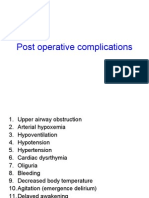100%(3)100% found this document useful (3 votes)
1K viewsCentral Venous Catheterization
Central Venous Catheterization
Uploaded by
drhiwaomerThis document provides guidance on central venous catheterization procedures. It describes the internal jugular and subclavian approaches. For the internal jugular approach, the catheter should be placed at the upper confluence of the sternocleidomastoid muscle at the level of the cricoid cartilage. The procedure involves locating the vein with a scout needle, inserting a catheter-over-needle, advancing a guidewire, and suturing the catheter in place. For the subclavian approach, the needle is inserted at the medial 1/3 of the clavicle and advanced until entering the vein. A guidewire and catheter are then inserted. A chest x-ray is needed post-procedure to confirm catheter placement and
Copyright:
Attribution Non-Commercial (BY-NC)
Available Formats
Download as PPT or read online from Scribd
Central Venous Catheterization
Central Venous Catheterization
Uploaded by
drhiwaomer100%(3)100% found this document useful (3 votes)
1K views20 pagesThis document provides guidance on central venous catheterization procedures. It describes the internal jugular and subclavian approaches. For the internal jugular approach, the catheter should be placed at the upper confluence of the sternocleidomastoid muscle at the level of the cricoid cartilage. The procedure involves locating the vein with a scout needle, inserting a catheter-over-needle, advancing a guidewire, and suturing the catheter in place. For the subclavian approach, the needle is inserted at the medial 1/3 of the clavicle and advanced until entering the vein. A guidewire and catheter are then inserted. A chest x-ray is needed post-procedure to confirm catheter placement and
Original Description:
surgical lecture
Copyright
© Attribution Non-Commercial (BY-NC)
Available Formats
PPT or read online from Scribd
Share this document
Did you find this document useful?
Is this content inappropriate?
This document provides guidance on central venous catheterization procedures. It describes the internal jugular and subclavian approaches. For the internal jugular approach, the catheter should be placed at the upper confluence of the sternocleidomastoid muscle at the level of the cricoid cartilage. The procedure involves locating the vein with a scout needle, inserting a catheter-over-needle, advancing a guidewire, and suturing the catheter in place. For the subclavian approach, the needle is inserted at the medial 1/3 of the clavicle and advanced until entering the vein. A guidewire and catheter are then inserted. A chest x-ray is needed post-procedure to confirm catheter placement and
Copyright:
Attribution Non-Commercial (BY-NC)
Available Formats
Download as PPT or read online from Scribd
Download as ppt
100%(3)100% found this document useful (3 votes)
1K views20 pagesCentral Venous Catheterization
Central Venous Catheterization
Uploaded by
drhiwaomerThis document provides guidance on central venous catheterization procedures. It describes the internal jugular and subclavian approaches. For the internal jugular approach, the catheter should be placed at the upper confluence of the sternocleidomastoid muscle at the level of the cricoid cartilage. The procedure involves locating the vein with a scout needle, inserting a catheter-over-needle, advancing a guidewire, and suturing the catheter in place. For the subclavian approach, the needle is inserted at the medial 1/3 of the clavicle and advanced until entering the vein. A guidewire and catheter are then inserted. A chest x-ray is needed post-procedure to confirm catheter placement and
Copyright:
Attribution Non-Commercial (BY-NC)
Available Formats
Download as PPT or read online from Scribd
Download as ppt
You are on page 1of 20
Central Venous
Catheterization
Dr. Hiwa Omer Ahmed
Assistant Professor
Indications for central venous
catheter cannulation:
Monitoring of central venous pressures in
shock or heart failure.
management of fluid status.
administration of total parenteral nutrition.
prolonged antimicrobial therapy or
chemotherapy
Location of catheterization site
A. The internal jugular approach should
not be used in patients with a carotid bruit,
carotid stenosis, or an aneurysm.
B. The subclavian approach should be
avoided in patients with emphysema or
bullae.
C. The external jugular or internal jugular
approach by direct cut-down may be
preferable in patients with coagulopathy or
thrombocytopenia.
D. If a chest tube already in place, the
catheter should be placed on the same
side as the chest tube
Internal jugular vein cannulation
The internal jugular vein is positioned
behind the sternocleidomastoid
muscle, lateral to the carotid artery
The catheter should be placed at a
location at the upper confluence of the two
bellies of sternocleidomastoid at the level
of cricoid cartilage.
Procedure
A. Place the patient in Trendelenburg's position,
and turn the patient's head to the contralateral
side. Choose a location on the right or left. If
lung function is symmetrical and no chest tubes
are in place, the right side is preferred because
of the direct path to the superior vena cava.
Prepare the skin with Betadine solution using
sterile technique and drape the area. Infiltrate
the skin and deeper tissues with 1% lidocaine
B. Palpate the carotid artery. Using a 22-
gauge scout needle and syringe, direct the
needle toward the ipsilateral nipple at a 30
degree angle to the neck. While
aspirating, advance the needle until the
vein is located and blood back flows into
the syringe
C. Remove the scout needle and advance an
18gauge,
thin wall, catheter-over-needle (with an attached
syringe) along the same path as the scout
needle. When back flow of blood is noted into
the syringe, advance the catheter into the vein.
Remove the needle and confirm back flow of
blood through the catheter and into the syringe.
Remove the syringe and cover the catheter hub
with a finger to prevent air embolization
D. With the catheter in position, advance a
guidewire through the catheter. The
guidewire should advance easily without
resistance
E. With the guidewire in position, remove
the catheter and use a No. 11 scalpel
blade to nick the skin. Place the central
vein catheter over the wire, holding
the wire secure at all times. Pass the
catheter into the vein, and suture the
catheter to the skin with O silk suture.
Tape the catheter in place, and connect it
to an IV infusion at a keep open rate
F. Obtain a chest x-ray to rule out
pneumothorax and confirm position.
Subclavian vein cannulation
The subclavian vein is located in the angle
formed by the medial 1/3 of clavicle and
the first rib , At the point of medial 1/3 and
middle 1/3
PROCEDURE
A. Position the patient supine with a rolled
towel located longitudinally between the
patient's scapulae,
and turn the patient’s head towards the
contralateral
side. Prepare the area with Betadine
iodine solution, and, using sterile
technique, drape the area and infiltrate 1%
lidocaine into the skin and tissues
B. Use a 16-gauge needle, with syringe
attached, to puncture the mid-point of the
clavicle, advancing until the clavicle bone
and needle come in contact
C. Then slowly probe down until the
needle slips under the clavicle. Advance
the needle slowly towards the vein until
the needle enters the vein, and a back
flow of venous blood enters the syringe.
Remove the syringe, and cover the
catheter hub with a finger to prevent air
embolization
D. With the 16-gauge catheter in position,
advance a 0.89 mm x 45 cm guidewire
through the catheter. The guidewire
should advance easily without resistance.
With the guidewire in position, remove the
catheter, and use a No. 11 scalpel blade
to nick the skin. Pass the dilator over the
wire.
E. Place the central line catheter over the
wire, holding
the wire secure at all times. Pass the
catheter into the vein, and suture the
catheter to the skin with 2-0 silk suture,
tape the catheter in place and connect to
IV infusion. Obtain a chest x-ray to confirm
the position of the catheter tip and rule out
pneumothorax
You might also like
- Sports Massage Therapy Consent FormDocument1 pageSports Massage Therapy Consent FormAndriusjoNo ratings yet
- Review Book OverviewDocument14 pagesReview Book OverviewRiya Nikhar0% (1)
- English-Kurdish - Arabic Medical DictionaryDocument110 pagesEnglish-Kurdish - Arabic Medical Dictionarydrhiwaomer80% (15)
- Patient SafetyDocument8 pagesPatient SafetyKelly J Wilson0% (1)
- Mechanical VentilationDocument13 pagesMechanical VentilationNithiya NadesanNo ratings yet
- Central Venous Pressure InsertionDocument22 pagesCentral Venous Pressure Insertionjeizy17No ratings yet
- Chest TraumaDocument115 pagesChest TraumaЕвгений ХанькоNo ratings yet
- Arterial Line Arterial LineDocument13 pagesArterial Line Arterial LineLinamaria Lozano100% (1)
- Bowel PreparationDocument16 pagesBowel PreparationKateAngeliRebosuraNo ratings yet
- BASIC LIFE SUPPORT Basics IntroductionDocument27 pagesBASIC LIFE SUPPORT Basics IntroductionMUKESH SUNDARARAJANNo ratings yet
- Arianna Mabunga BSN-3B Urinary Diversion DeffinitionDocument5 pagesArianna Mabunga BSN-3B Urinary Diversion DeffinitionArianna Jasmine Mabunga0% (1)
- Renal Abscess, Xanthogranulomatous Pyelonephritis and Renal TuberculosisDocument41 pagesRenal Abscess, Xanthogranulomatous Pyelonephritis and Renal TuberculosisAnas Mk HindawiNo ratings yet
- EndosDocument38 pagesEndosYogi AnjasmaraNo ratings yet
- Approach To Spontaneous PneumothoraxDocument25 pagesApproach To Spontaneous PneumothoraxMohdGhazaliAcoyNo ratings yet
- Laryngeal Mask LmaDocument25 pagesLaryngeal Mask LmaCiptadi IqbalNo ratings yet
- BY DR Muhammad Akram M.C.H.JeddahDocument32 pagesBY DR Muhammad Akram M.C.H.JeddahMuhammad Akram Qaim KhaniNo ratings yet
- Hemodialysis in ChildrenDocument28 pagesHemodialysis in ChildrenKarna Yuli sitanggangNo ratings yet
- Thoracic Injuries 1Document32 pagesThoracic Injuries 1awais mpNo ratings yet
- UGIHDocument59 pagesUGIHEkkawit IamthonginNo ratings yet
- Suppurative Lung Diseases: DR Faisal Moidunny Mammu Department of PaediatricsDocument39 pagesSuppurative Lung Diseases: DR Faisal Moidunny Mammu Department of PaediatricsFaisal MoidunnyNo ratings yet
- Fulminant Hepatic FailureDocument12 pagesFulminant Hepatic Failureafghansyah arfiantoNo ratings yet
- Penetrating Chest InjuryDocument33 pagesPenetrating Chest InjuryJARRIE BADJIENo ratings yet
- Medical Surgical Nursing Suretech College of NursingDocument18 pagesMedical Surgical Nursing Suretech College of NursingSanket TelangNo ratings yet
- Liver Abscess Clinical Presentation - History, Physical Examination, ComplicationsDocument2 pagesLiver Abscess Clinical Presentation - History, Physical Examination, ComplicationsAdi Kurnia100% (1)
- Secondary Puj ObstructionDocument22 pagesSecondary Puj ObstructionGurmeet SinghNo ratings yet
- Clinical Manifestations and Diagnosis of Urinary Tract Obstruction and Hydroneph PDFDocument32 pagesClinical Manifestations and Diagnosis of Urinary Tract Obstruction and Hydroneph PDFAmjad Saud0% (1)
- OxygenationDocument50 pagesOxygenationLulu MushiNo ratings yet
- Surgical ComplicationsDocument41 pagesSurgical ComplicationsFrida AtallahNo ratings yet
- Diagnostic Liver Biopsy PDFDocument7 pagesDiagnostic Liver Biopsy PDFAriadna MarielNo ratings yet
- Combitube: IndicationDocument3 pagesCombitube: IndicationV IdyaNo ratings yet
- Intrahospital Transport of Critically Ill PatientsDocument14 pagesIntrahospital Transport of Critically Ill Patientsعزالدين الزوقريNo ratings yet
- PneumothoraxDocument3 pagesPneumothoraxSanthosh.S.UNo ratings yet
- Continuous Renal Replacement TherapyDocument38 pagesContinuous Renal Replacement Therapyanju rachel joseNo ratings yet
- Abdominal Paracentesis, AP, Abdominal TapDocument32 pagesAbdominal Paracentesis, AP, Abdominal TapMeraflor BahonsuaNo ratings yet
- What Is A Gastrectomy?Document4 pagesWhat Is A Gastrectomy?Priyanka JangraNo ratings yet
- Rapid Sequence Intubation and Cricoid PressureDocument16 pagesRapid Sequence Intubation and Cricoid PressureErlin IrawatiNo ratings yet
- Diagnostic Thoracoscopy (VATS) in Lung CancerDocument18 pagesDiagnostic Thoracoscopy (VATS) in Lung CancerlmdarlongNo ratings yet
- Approach To Patient With Splenomegaly 2Document57 pagesApproach To Patient With Splenomegaly 2Saja SaqerNo ratings yet
- Necrotizing InfectionsDocument57 pagesNecrotizing InfectionsRuffaeelJabrNo ratings yet
- Lumbar Puncture (Lumbar Tap)Document21 pagesLumbar Puncture (Lumbar Tap)Paul Gabriel CasquejoNo ratings yet
- Acute Mesenteric IschemiaDocument20 pagesAcute Mesenteric IschemiasolysanNo ratings yet
- Acute Pyelonephritis Treatment & Management: Approach ConsiderationsDocument4 pagesAcute Pyelonephritis Treatment & Management: Approach ConsiderationsPeter InocandoNo ratings yet
- Airway Obstruction - Types, Causes, and SymptomsDocument6 pagesAirway Obstruction - Types, Causes, and SymptomsGilbertLiem100% (1)
- Fluid Management in Major Burn Injuries PDFDocument10 pagesFluid Management in Major Burn Injuries PDFTri BasukiNo ratings yet
- Nursing Cares For Hemodialysis Patient: Hemodialysis Vascular Access: Assess TheDocument34 pagesNursing Cares For Hemodialysis Patient: Hemodialysis Vascular Access: Assess TheEDz Delica SandovalNo ratings yet
- Anti Arrhythmic DrugsDocument91 pagesAnti Arrhythmic DrugsAlex beharuNo ratings yet
- Kidney TransplantDocument11 pagesKidney TransplantPrincess Xzmae RamirezNo ratings yet
- Instillation of Normal Saline in Endotracheal SuctioningDocument2 pagesInstillation of Normal Saline in Endotracheal SuctioningChiyouaLoverz Tharaztic JRsNo ratings yet
- Chest Tube and Water-Seal DrainageDocument25 pagesChest Tube and Water-Seal DrainageGhadaNo ratings yet
- Post Resus CareDocument35 pagesPost Resus Caredrjaikrish100% (1)
- Renal Transplantation: Name: Jyotishman Bharali Class: X-B Roll No: 19Document12 pagesRenal Transplantation: Name: Jyotishman Bharali Class: X-B Roll No: 19Jyotishman Bharali100% (1)
- Stricture Urethra PDFDocument12 pagesStricture Urethra PDFNasti YL HardiansyahNo ratings yet
- Endotracheal IntubationDocument33 pagesEndotracheal IntubationReza Dyan Perdani ZeinNo ratings yet
- Physical Examination of The 4 Genitourinary TractDocument12 pagesPhysical Examination of The 4 Genitourinary TractrudybisNo ratings yet
- Pelvic FracturesDocument8 pagesPelvic FracturesArif AbubakarNo ratings yet
- Gastrointestinal EndosDocument28 pagesGastrointestinal EndosAqeel AhmedNo ratings yet
- Blood Transfusion ICUDocument64 pagesBlood Transfusion ICUSherif ElbadrawyNo ratings yet
- Endovascular Surgery - BenkőDocument33 pagesEndovascular Surgery - BenkőpampaszNo ratings yet
- Appendicitis in Children Vineyard (Dr. Faisol)Document28 pagesAppendicitis in Children Vineyard (Dr. Faisol)Alinta AyuningtyasNo ratings yet
- Cystoscopy 508Document6 pagesCystoscopy 508Jayakumar D SwamyNo ratings yet
- Anesthesia and ResuscitationDocument24 pagesAnesthesia and ResuscitationaviabiNo ratings yet
- A Simple Guide to Circulatory Shock, Diagnosis, Treatment and Related ConditionsFrom EverandA Simple Guide to Circulatory Shock, Diagnosis, Treatment and Related ConditionsNo ratings yet
- Liver Haemangioma ResectionDocument38 pagesLiver Haemangioma ResectiondrhiwaomerNo ratings yet
- Thyroid& ParathyroidDocument98 pagesThyroid& Parathyroiddrhiwaomer100% (12)
- Laparoscopy AtlasDocument199 pagesLaparoscopy Atlasdrhiwaomer100% (2)
- Day Case Surgery 1LDocument21 pagesDay Case Surgery 1LdrhiwaomerNo ratings yet
- Surgical Bed Side ProceduressDocument62 pagesSurgical Bed Side Proceduressdrhiwaomer100% (1)
- ژوان Kurdish Short storyDocument2 pagesژوان Kurdish Short storydrhiwaomerNo ratings yet
- GlaiyDocument1 pageGlaiydrhiwaomerNo ratings yet
- Indications in SrgeryDocument73 pagesIndications in Srgerydrhiwaomer100% (4)
- Hepatoblastoma ResectionDocument21 pagesHepatoblastoma ResectiondrhiwaomerNo ratings yet
- Indications and Contraindications of Laparoscopy1Document18 pagesIndications and Contraindications of Laparoscopy1drhiwaomer100% (2)
- Laparoscopic Management of Ectopic PregnancyDocument7 pagesLaparoscopic Management of Ectopic Pregnancydrhiwaomer100% (3)
- Laparoscopic Tubal SterilizationDocument8 pagesLaparoscopic Tubal SterilizationdrhiwaomerNo ratings yet
- Laparoscopic Tubal SterilizationDocument8 pagesLaparoscopic Tubal SterilizationdrhiwaomerNo ratings yet
- Diagnostic LaparosDocument8 pagesDiagnostic Laparosdrhiwaomer100% (3)
- CV DR Ari Sami 2008Document4 pagesCV DR Ari Sami 2008drhiwaomer100% (2)
- Post Operative ComplicationsDocument17 pagesPost Operative Complicationsdrhiwaomer100% (8)
- Kurdish / Arabic/englsh Medical DictionaryDocument82 pagesKurdish / Arabic/englsh Medical Dictionarydrhiwaomer89% (9)
- Intravenous Anesthetic AgentsDocument23 pagesIntravenous Anesthetic Agentsdrhiwaomer100% (7)
- PremedicationDocument9 pagesPremedicationdrhiwaomer100% (3)
- Surgical Outcome of Cerebellar Tumors in ChildrenDocument10 pagesSurgical Outcome of Cerebellar Tumors in ChildrendrhiwaomerNo ratings yet
- Anesthesia Lecture 3Document25 pagesAnesthesia Lecture 3drhiwaomer100% (2)
- Anesthesia Lecture 3Document25 pagesAnesthesia Lecture 3drhiwaomer100% (2)
- Inhalational AgentsDocument12 pagesInhalational Agentsdrhiwaomer100% (1)
- Anesthesia Lecture 1Document16 pagesAnesthesia Lecture 1drhiwaomer100% (9)
- Metastatized Colonic CancerDocument17 pagesMetastatized Colonic Cancerdrhiwaomer100% (3)
- High Output Renal FailureDocument4 pagesHigh Output Renal Failuredrhiwaomer100% (1)
- Recent Concepts in Minimal Access Surgery: Deborshi Sharma Priya HazrahDocument492 pagesRecent Concepts in Minimal Access Surgery: Deborshi Sharma Priya HazrahlakshitNo ratings yet
- 2016 Fdi CPP White PaperDocument59 pages2016 Fdi CPP White PaperAnggita DewiNo ratings yet
- Application PDF FormatDocument13 pagesApplication PDF FormatnokulungalebzamNo ratings yet
- Initiating Coverage On UnichemDocument26 pagesInitiating Coverage On UnichemUpendra KumarNo ratings yet
- Self-Compassion in Clinical PracticeDocument13 pagesSelf-Compassion in Clinical PracticeMircea PocolNo ratings yet
- Drug Information ResourcesDocument34 pagesDrug Information ResourceslucaNo ratings yet
- ChecklistDocument2 pagesChecklistRuzi Falahi KautsarNo ratings yet
- Prototipo de HealthDocument88 pagesPrototipo de HealthPaco GilNo ratings yet
- IMCI - For PakistanDocument35 pagesIMCI - For Pakistanerajkhan100% (1)
- Ciroza LaboratorDocument2 pagesCiroza LaboratorMihaela IonescuNo ratings yet
- Clinical Reliability of The Furcation Arrow As A Diagnostic MarkerDocument6 pagesClinical Reliability of The Furcation Arrow As A Diagnostic MarkerGabriela GuerraNo ratings yet
- D5AFAF0Fd01 PDFDocument148 pagesD5AFAF0Fd01 PDFGoran VasićNo ratings yet
- Nephrotic Syndrome: DR Thuvaraka WareDocument5 pagesNephrotic Syndrome: DR Thuvaraka Warechloe1411No ratings yet
- Preparation of Extensively Damaged Vital TeethDocument13 pagesPreparation of Extensively Damaged Vital TeethShu Nser100% (2)
- Takepron+capsules+E 20110614Document28 pagesTakepron+capsules+E 20110614Mauly Dina SafitriNo ratings yet
- WM ALS Quarter 1 Module 1Document7 pagesWM ALS Quarter 1 Module 1RUTH MAE GULENGNo ratings yet
- Effect of Glycine Powder Air Polishing On The Gingiva PetersDocument9 pagesEffect of Glycine Powder Air Polishing On The Gingiva PetersJeremy VoNo ratings yet
- Non-Hodgkin Lymphoma: Medicine March 2017Document9 pagesNon-Hodgkin Lymphoma: Medicine March 2017devaaNo ratings yet
- OsteoarthritisDocument11 pagesOsteoarthritisadddNo ratings yet
- How The Frolov Device Works Plus ResultsDocument14 pagesHow The Frolov Device Works Plus ResultsAnonymous hndaj8zCA100% (1)
- Psych LectureDocument21 pagesPsych LectureAntoinette PeleñaNo ratings yet
- Drug Study ParacetamolDocument1 pageDrug Study ParacetamolIris BalinoNo ratings yet
- Mga Resulta Sa Paghahanap: ConclusionDocument2 pagesMga Resulta Sa Paghahanap: ConclusionKengkai MiiNo ratings yet
- Geeks Lab 6 ButerflyDocument7 pagesGeeks Lab 6 ButerflyMatthew Spencer HoNo ratings yet
- Zoladex 3.6mg Implant - Summary of Product Characteristics (SMPC) - Print Friendly - (Emc)Document8 pagesZoladex 3.6mg Implant - Summary of Product Characteristics (SMPC) - Print Friendly - (Emc)KunalNo ratings yet
- Psychosomatic DisordersDocument11 pagesPsychosomatic DisordersJasmin Jacob100% (3)
- Practical Homoepathy D S Vohra.01577 2case StuediesDocument4 pagesPractical Homoepathy D S Vohra.01577 2case StuediessumarumNo ratings yet


















































































































